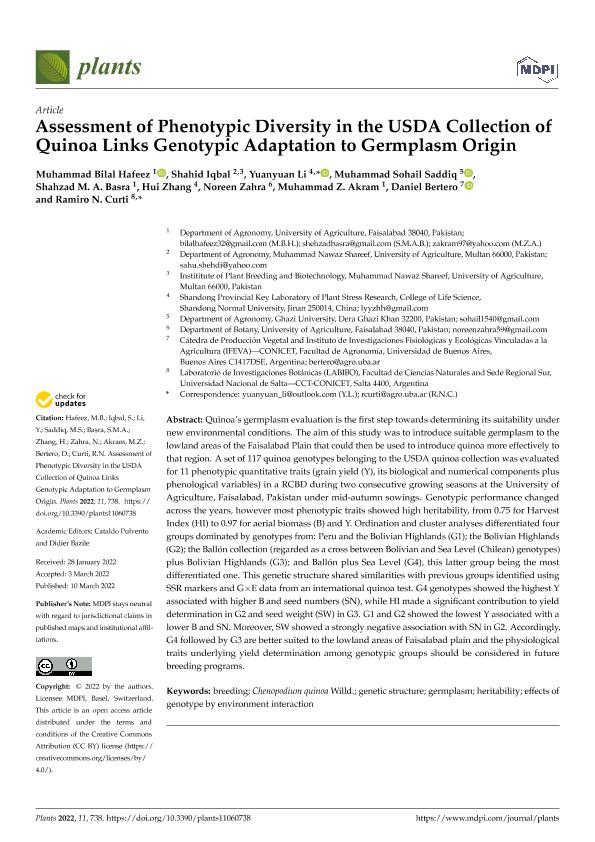Mostrar el registro sencillo del ítem
dc.contributor.author
Hafeez, Muhammad Bilal
dc.contributor.author
Iqbal, Shahid
dc.contributor.author
Li, Yuanyuan
dc.contributor.author
Saddiq, Muhammad Sohail
dc.contributor.author
Basra, Shahzad M. A.
dc.contributor.author
Zhang, Hui
dc.contributor.author
Zahra, Noreen
dc.contributor.author
Akram, Muhammad Z.
dc.contributor.author
Bertero, Hector Daniel

dc.contributor.author
Curti, Ramiro Nestor

dc.date.available
2022-06-23T19:18:35Z
dc.date.issued
2022-03
dc.identifier.citation
Hafeez, Muhammad Bilal; Iqbal, Shahid; Li, Yuanyuan; Saddiq, Muhammad Sohail; Basra, Shahzad M. A.; et al.; Assessment of phenotypic diversity in the USDA collection of quinoa links genotypic adaptation to germplasm origin; Multidisciplinary Digital Publishing Institute; Plants; 11; 6; 3-2022; 1-13
dc.identifier.uri
http://hdl.handle.net/11336/160411
dc.description.abstract
Quinoa’s germplasm evaluation is the first step towards determining its suitability under new environmental conditions. The aim of this study was to introduce suitable germplasm to the lowland areas of the Faisalabad Plain that could then be used to introduce quinoa more effectively to that region. A set of 117 quinoa genotypes belonging to the USDA quinoa collection was evaluated for 11 phenotypic quantitative traits (grain yield (Y), its biological and numerical components plus phenological variables) in a RCBD during two consecutive growing seasons at the University of Agriculture, Faisalabad, Pakistan under mid-autumn sowings. Genotypic performance changed across the years, however most phenotypic traits showed high heritability, from 0.75 for Harvest Index (HI) to 0.97 for aerial biomass (B) and Y. Ordination and cluster analyses differentiated four Academic Editors: Cataldo Pulvento and Didier Bazile Received: 28 January 2022 Accepted: 3 March 2022 Published: 10 March 2022 Publisher’s Note: MDPI stays neutral with regard to jurisdictional claims in published maps and institutional affiliations. Copyright: © 2022 by the authors. Licensee MDPI, Basel, Switzerland. This article is an open access article distributed under the terms and conditions of the Creative Commons Attribution (CC BY) license (https:// creativecommons.org/licenses/by/ 4.0/). groups dominated by genotypes from: Peru and the Bolivian Highlands (G1); the Bolivian Highlands (G2); the Ballón collection (regarded as a cross between Bolivian and Sea Level (Chilean) genotypes) plus Bolivian Highlands (G3); and Ballón plus Sea Level (G4), this latter group being the most differentiated one. This genetic structure shared similarities with previous groups identified using SSR markers and G×Edata from an international quinoa test. G4 genotypes showed the highest Y associated with higher B and seed numbers (SN), while HI made a significant contribution to yield determination in G2 and seed weight (SW) in G3. G1 and G2 showed the lowest Y associated with a lower B and SN. Moreover, SW showed a strongly negative association with SN in G2. Accordingly, G4followed by G3 are better suited to the lowland areas of Faisalabad plain and the physiological traits underlying yield determination among genotypic groups should be considered in future breeding programs.
dc.format
application/pdf
dc.language.iso
eng
dc.publisher
Multidisciplinary Digital Publishing Institute
dc.rights
info:eu-repo/semantics/openAccess
dc.rights.uri
https://creativecommons.org/licenses/by/2.5/ar/
dc.subject
BREEDING
dc.subject
CHENOPODIUM QUINOA WILLD.
dc.subject
GENETIC STRUCTURE
dc.subject
GERMPLASM
dc.subject
HERITABILITY
dc.subject
EFFECTS OF GENOTYPE BY ENVIRONMENT INTERACTION
dc.subject.classification
Agricultura

dc.subject.classification
Agricultura, Silvicultura y Pesca

dc.subject.classification
CIENCIAS AGRÍCOLAS

dc.title
Assessment of phenotypic diversity in the USDA collection of quinoa links genotypic adaptation to germplasm origin
dc.type
info:eu-repo/semantics/article
dc.type
info:ar-repo/semantics/artículo
dc.type
info:eu-repo/semantics/publishedVersion
dc.date.updated
2022-06-21T18:32:41Z
dc.identifier.eissn
2223-7747
dc.journal.volume
11
dc.journal.number
6
dc.journal.pagination
1-13
dc.journal.pais
Suiza

dc.journal.ciudad
Basilea
dc.description.fil
Fil: Hafeez, Muhammad Bilal. University Of Agriculture; Pakistán
dc.description.fil
Fil: Iqbal, Shahid. University Of Agriculture; Pakistán
dc.description.fil
Fil: Li, Yuanyuan. Shandong Normal University. College of Life Science. Shandong Provincial Key Laboratory of Plant Stress Research; China
dc.description.fil
Fil: Saddiq, Muhammad Sohail. Ghazi University. Department of Agronomy; Pakistán
dc.description.fil
Fil: Basra, Shahzad M. A.. University Of Agriculture; Pakistán
dc.description.fil
Fil: Zhang, Hui. Shandong Normal University. College of Life Science. Shandong Provincial Key Laboratory of Plant Stress Research; China
dc.description.fil
Fil: Zahra, Noreen. University Of Agriculture; Pakistán
dc.description.fil
Fil: Akram, Muhammad Z.. University Of Agriculture; Pakistán
dc.description.fil
Fil: Bertero, Hector Daniel. Consejo Nacional de Investigaciones Científicas y Técnicas; Argentina. Universidad de Buenos Aires. Facultad de Agronomía. Departamento de Producción Vegetal. Cátedra de Producción Vegetal; Argentina
dc.description.fil
Fil: Curti, Ramiro Nestor. Consejo Nacional de Investigaciones Científicas y Técnicas. Centro Científico Tecnológico Conicet - Salta; Argentina. Universidad Nacional de Salta. Facultad de Ciencias Naturales. Escuela de Agronomía. Laboratorio de Investigaciones Botánicas; Argentina
dc.journal.title
Plants
dc.relation.alternativeid
info:eu-repo/semantics/altIdentifier/url/https://www.mdpi.com/2223-7747/11/6/738
dc.relation.alternativeid
info:eu-repo/semantics/altIdentifier/doi/http://dx.doi.org/10.3390/plants11060738
Archivos asociados
